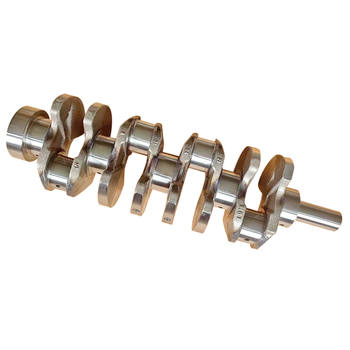
A crankshaft is the backbone of your engine, converting the reciprocating motion of the pistons into rotational energy that powers your vehicle. When this crucial component fails, it often leads to catastrophic engine damage. So, what destroys a crankshaft? Let's delve into the common culprits and discuss how to prevent this expensive headache.
Lack of Lubrication: The Silent Killer
Perhaps the most frequent cause of crankshaft failure is inadequate lubrication. Oil starvation, caused by low oil levels, a clogged oil filter, or a faulty oil pump, deprives the crankshaft bearings of the vital film of oil needed to prevent metal-on-metal contact. This friction generates excessive heat and wear, ultimately leading to bearing failure and potential crankshaft damage. Regularly checking your oil level and adhering to your vehicle's recommended oil change schedule are crucial preventative measures.
Detonation: The Explosive Threat
Detonation, also known as knocking or pinging, is an uncontrolled explosion of the air/fuel mixture in the combustion chamber. These powerful shockwaves can put immense stress on the crankshaft, leading to cracks or even complete breakage. Common causes of detonation include low-octane fuel, excessive engine temperatures, and improper ignition timing. Addressing these issues promptly can safeguard your crankshaft from this explosive threat. Have you ever heard a knocking sound coming from your engine? It's a sign you shouldn't ignore.
Connecting Rod Failure: A Chain Reaction
The connecting rods link the pistons to the crankshaft, transmitting the force of combustion. When a connecting rod fails, it can create havoc within the engine. A broken connecting rod can strike the crankshaft with tremendous force, causing bending, cracking, or even complete fracture. Proper maintenance and timely replacement of worn connecting rods are vital to prevent this chain reaction of destruction.
Hydrolock: The Water Hazard
Hydrolock occurs when liquid, usually water, enters the engine cylinders. Since liquids cannot be compressed like air, the pistons are forced to stop abruptly during their upward stroke. This sudden stop transfers immense force to the connecting rods and, ultimately, the crankshaft, often leading to bending or breakage. Avoiding driving through deep water and addressing coolant leaks promptly can help prevent hydrolock and protect your crankshaft.
Excessive Bearing Wear: The Gradual Decline
Over time, crankshaft bearings wear down due to normal operation. However, factors like contaminated oil, high engine loads, and excessive vibrations can accelerate this wear. Worn bearings increase friction and heat, potentially leading to crankshaft damage. Regular engine maintenance and timely replacement of worn bearings are essential to prevent this gradual decline.
Crankshaft Fatigue: The Metal's Breaking Point
Crankshafts are designed to withstand immense forces, but repeated stress cycles can eventually lead to metal fatigue. This weakening of the metal can result in cracks, particularly in areas of high stress concentration. Proper engine balancing and avoiding excessive engine speeds can help mitigate crankshaft fatigue. Think of it like bending a paperclip back and forth – eventually, it will break.
Improper Installation: The Human Error
Even with a perfectly healthy crankshaft, improper installation can lead to premature failure. Incorrect torque specifications, misaligned components, and the use of incorrect bearings can create stress points and accelerate wear. Always follow the manufacturer's recommended installation procedures and entrust complex engine work to qualified mechanics. This is one area where cutting corners can have disastrous consequences.
Preventing Crankshaft Failure: Proactive Measures
So, how can you prevent what destroys a crankshaft and prolong the life of your engine? Regular maintenance is key. Adhering to recommended oil change intervals, using the correct oil viscosity, and regularly inspecting for leaks and unusual noises can help identify potential problems early on. Addressing minor issues promptly can prevent them from escalating into major crankshaft failures.
What destroys a crankshaft, and how can you protect yours?
By understanding the common causes of crankshaft damage, you can take proactive steps to protect your engine and avoid costly repairs. Regular maintenance, prompt attention to warning signs, and responsible driving habits are essential for maintaining a healthy crankshaft and extending the life of your vehicle.
Next Steps: Protecting Your Investment
Don’t wait for a catastrophic engine failure to learn about crankshaft damage. Schedule a preventative maintenance check with a qualified mechanic today. They can assess the health of your engine, identify potential issues, and recommend the necessary steps to keep your crankshaft spinning smoothly for years to come. Protecting your engine is an investment in the longevity of your vehicle.

 The Unseen Powerhouse: Unveili
The Unseen Powerhouse: Unveili
 Unveiling the Precision: The A
Unveiling the Precision: The A
 Navigating the World of Cranks
Navigating the World of Cranks
 The Unsung Heroes: What Makes
The Unsung Heroes: What Makes
